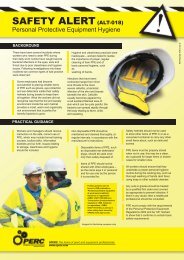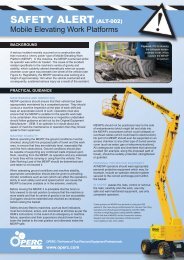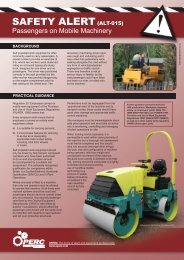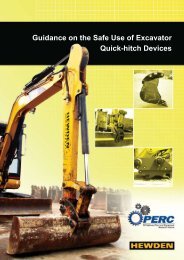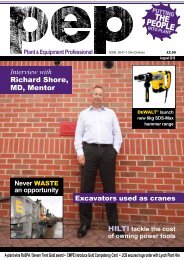the PeoPle - OPERC - Off-highway Plant and Equipment Research ...
the PeoPle - OPERC - Off-highway Plant and Equipment Research ...
the PeoPle - OPERC - Off-highway Plant and Equipment Research ...
You also want an ePaper? Increase the reach of your titles
YUMPU automatically turns print PDFs into web optimized ePapers that Google loves.
However, what is a more complex<br />
problem to solve is why fully trained<br />
<strong>and</strong> competent operators still knowingly<br />
undertake unsafe behaviour on site.<br />
There are a variety of factors which<br />
may explain such intentional violations.<br />
In some instances, as seen in case<br />
study no 3, <strong>the</strong> individual may pursue<br />
<strong>the</strong> classic “I’ve always done <strong>the</strong><br />
job this way” approach, where <strong>the</strong><br />
unsafe behaviour has become <strong>the</strong><br />
normal way of working to achieve<br />
a task <strong>and</strong> <strong>the</strong> perception of <strong>the</strong><br />
associated risks has diminished.<br />
Workers will also find it hard to follow<br />
certain rules <strong>and</strong> procedures when<br />
<strong>the</strong>ir deliberate avoidance is rewarded<br />
by time saving <strong>and</strong> achieving extra<br />
production. This is a real issue at<br />
present under <strong>the</strong> current economic<br />
climate. In reality many of us are<br />
guilty to some extent of bending <strong>the</strong><br />
rules, skipping procedure or lapses<br />
in concentration. For example,<br />
consider a worker that is faced with<br />
a 10 to 15 minute period to put on<br />
<strong>the</strong> correct clothing <strong>and</strong> equipment<br />
to enter a m<strong>and</strong>atory PPE area<br />
to read a gauge that takes 10<br />
seconds? Whilst adopting <strong>the</strong> unsafe<br />
behaviour cannot be condoned, this<br />
does illustrate how <strong>the</strong> temptation<br />
can arise at an individual level.<br />
Weak, or ineffective, management can<br />
significantly nurture bad behaviour.<br />
This could include: sometimes turning<br />
a blind eye to unsafe behaviour<br />
for <strong>the</strong> sake of production; actively<br />
encouraging employees to take<br />
short cuts; transmitting conflicting<br />
messages that undermine employee<br />
confidence in <strong>the</strong> safety system; <strong>and</strong><br />
giving an impression that unsafe<br />
behaviour pays. However, more often<br />
than not, it is simply <strong>the</strong> issue of<br />
management being ignorant of safe<br />
machine operation on site (including<br />
site set-up, operating <strong>and</strong> so on) that<br />
can play a large role in <strong>the</strong> existent (or<br />
non-existent!) safety culture on site.<br />
how do we stop<br />
unsafe behaviour?<br />
One way of reducing incidents is to<br />
eliminate hazards by engineering <strong>the</strong>m<br />
out or introducing physical controls.<br />
Such engineering solutions have a<br />
strong place in safety management,<br />
particularly for skill-based errors<br />
such as slips or lapses, where <strong>the</strong><br />
operative makes a mistake <strong>and</strong><br />
does not do what he meant to do,<br />
particularly prevalent in maintenance<br />
<strong>and</strong> repair tasks. However such<br />
solutions cannot be relied upon <strong>and</strong><br />
<strong>the</strong> real key is knowledge, skill <strong>and</strong><br />
competence within <strong>the</strong> workforce<br />
<strong>and</strong> management team – <strong>the</strong> safety<br />
knowledge <strong>and</strong> capability factor.<br />
There also has to be a willingness<br />
to engage in best practice <strong>and</strong> this<br />
may involve changing <strong>the</strong> attitudes<br />
<strong>and</strong> culture of both operators <strong>and</strong><br />
managers on site. Campaigns <strong>and</strong><br />
targeted training can be implemented<br />
in an attempt to change attitudes<br />
to <strong>the</strong> health <strong>and</strong> safety culture<br />
but in practical terms how far is<br />
this possible <strong>and</strong> fur<strong>the</strong>rmore do<br />
attitudes determine behaviour?<br />
Punishment for bad behaviour may be<br />
viewed as an option <strong>and</strong> ultimately,<br />
in gross misconduct cases, one has<br />
very little option but to pursue such.<br />
Special reports, Latest news, Worldwide distribution & Expert opinions<br />
SPECIAL REPORT<br />
However, do we want to produce a<br />
culture of relying on authority, fear<br />
<strong>and</strong> punishment which may anyway<br />
lead to accidents <strong>and</strong> near misses not<br />
being reported for fear of sanctions.<br />
In <strong>the</strong> majority of cases individuals<br />
respond far better to praise than<br />
punishment – praise for: reporting an<br />
incident that could save a colleague’s<br />
life; contributing to best practice on site;<br />
supporting o<strong>the</strong>rs implement a safety<br />
strategy; effectively communicating key<br />
safety messages via taught courses;<br />
<strong>and</strong> acknowledging <strong>the</strong> team effort<br />
when reporting upon good practice<br />
via formal recognition schemes –<br />
prizes, awards <strong>and</strong> gala events.<br />
Building a safe team requires trust <strong>and</strong><br />
confidence between line managers <strong>and</strong><br />
<strong>the</strong> workforce. Employees <strong>the</strong>mselves<br />
are best placed to re-define safety<br />
norms on site as <strong>the</strong>y control <strong>the</strong>ir own<br />
behaviour but line management are<br />
best placed to facilitate <strong>the</strong> process in<br />
a blame free proactive safety culture.<br />
So in summary, can behavioural<br />
safety be improved - overwhelmingly,<br />
<strong>the</strong> answer is, YES.<br />
April 2011<br />
19



